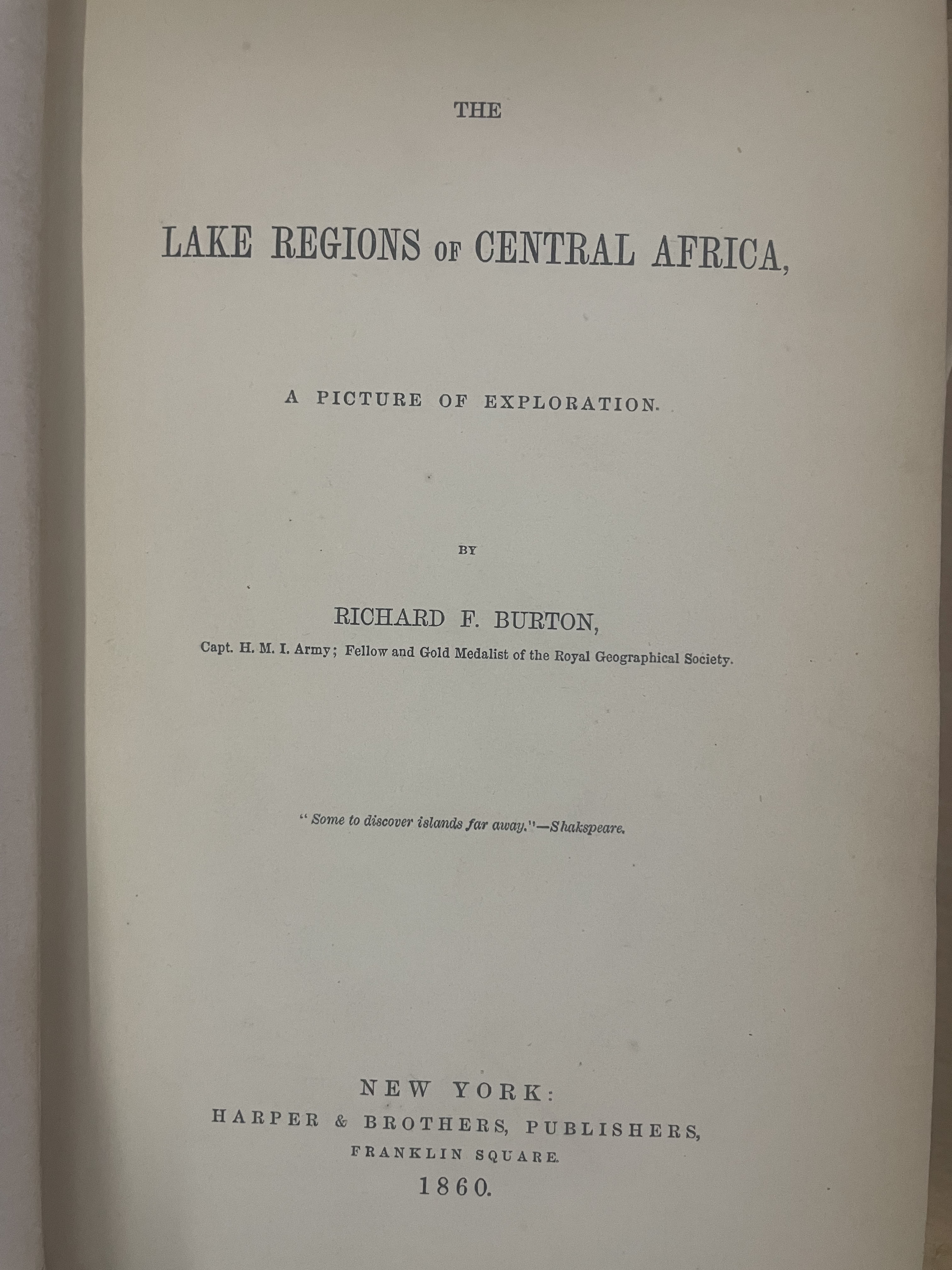The Lake Regions of Central Africa A picture of exploration

About
Summary
Exquisite
TOC
Details
Related
URL
Images
Overview
Richard Francis Burton's The Lake Regions of Central Africa: A Picture of Exploration, published in 1860, is a two-volume account of his expedition to Central Africa in search of the source of the Nile. This detailed work explores geographical and ethnological matters, showcasing Burton's observations and experiences during his journey to Zanzibar and the lake regions of present-day Tanzania.Richard Francis Burton (1821–1890) was a renowned explorer, linguist, and writer who served in the Bombay army, mastering over forty languages and dialects. His two-year African expedition aimed to discover the source of the Nile, funded by the Royal Geographical Society. The Lake Regions of Central Africa documents this journey, providing insights into the geography, ethnology, and commerce of the region.
Importance of Book
Geographical and Ethnological Documentation: Burton's detailed observations provide valuable insights into the geography, ethnology, and natural history of Central Africa. The book serves as a primary source for understanding the region and its people in the mid-19th century.
Exploration Narrative: Burton's vivid writing style and adventurous spirit make the book an engaging read. His account captures the excitement and challenges of exploration, offering a glimpse into the life of a 19th-century explorer.
Historical Context: The book provides valuable context for understanding the history of European exploration and colonialism in Africa. It reflects the attitudes, motivations, and assumptions of the time, shedding light on the complex relationship between Europe and Africa.
Linguistic Talent: Burton's linguistic talent allowed him to communicate with various tribes and understand their cultures. His ability to master over forty languages enhanced the richness and depth of his ethnographic observations.
Key Themes
Exploration and Discovery: The book emphasizes the thrill of exploration and the challenges of navigating unknown territories. Burton's detailed descriptions of the landscape, climate, and natural resources provide valuable geographical information.
Ethnographic Observations: Burton offers extensive observations on the customs, traditions, and social structures of the African tribes he encountered. His insights into village life, native character, religion, and government provide a comprehensive ethnographic record.
Colonialism and Imperialism: The expedition was conducted during the height of European colonialism, and the book reflects the attitudes and assumptions of the time. Burton's perspective on the African people and their societies is shaped by the prevailing colonial mindset.
Commerce and Trade: Burton includes an appendix on commerce in the region, detailing the imports, exports, and trade routes. This highlights the economic interests driving European exploration and the potential for commercial exploitation of African resources.
The Search for the Nile's Source: A primary objective of the expedition was to locate the source of the Nile, a quest that had captivated explorers for centuries. While Burton and Speke reached Lake Tanganyika and Lake Victoria, the dispute over which lake was the true source led to a falling out between them.
Cultural Significance
The Lake Regions of Central Africa holds cultural significance as a reflection of Victorian-era exploration and the European fascination with the unknown regions of the world. The book contributed to the construction of European perceptions of Africa, shaping public opinion and influencing colonial policies. Burton's work also reflects the scientific and intellectual currents of the time, including an interest in geography, ethnology, and natural history.
Effects on Society
Shaping Perceptions of Africa: Burton's book played a role in shaping European perceptions of Africa, influencing public opinion and contributing to the construction of colonial ideologies. His descriptions of African people and their societies, while often biased, helped to create a sense of familiarity with the continent.
Stimulating Further Exploration: Burton's expedition and his subsequent book inspired other explorers and adventurers to venture into Africa. The quest to discover the source of the Nile and other geographical mysteries continued to drive exploration efforts in the late 19th century.
Facilitating Colonial Expansion: The knowledge gained from Burton's expedition and other explorations facilitated European colonial expansion in Africa. The identification of resources, trade routes, and strategic locations helped European powers establish their presence and control over the continent.
Contributing to Ethnographic Knowledge: Burton's detailed ethnographic observations contributed to the growing body of knowledge about African cultures and societies. While his interpretations were often shaped by colonial biases, his work provided valuable data for anthropologists and other researchers.
Conclusion
The Lake Regions of Central Africa: A Picture of Exploration by Richard Francis Burton is a significant historical document that provides valuable insights into the geography, ethnology, and colonial history of Central Africa. Despite its biases and controversies, the book remains an important source for understanding the European exploration of Africa and the complex relationship between Europe and the African continent. Burton's detailed observations, vivid writing style, and adventurous spirit make this book a compelling read for anyone interested in exploration, travel, and the history of colonialism.
Title
The Lake Regions of Central Africa A picture of exploration
Author
Richard Francis Burton
Name of Publisher
Harper and Brothers
Publish Date
1860
Subject
This is an account of Burton?s travels and explorations in Central Africa, focusing on the lake regions. This book provides a detailed narrative of his journeys and observations.
Vintage
1801-1900
Number of Pages
572
Category
Travel
Sub Category
Social Sciences
Rarity
RARE
